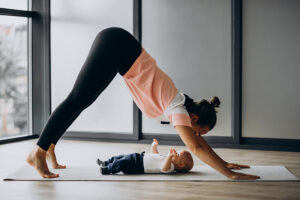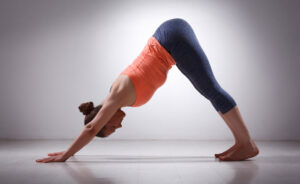Unveiling the Magic of Prenatal Yoga: A Journey of Movement and Mindfulness
Imagine yourself blossoming with new life, embarking on a transformative journey filled with both excitement and challenges. During pregnancy, the search for safe and effective ways to nurture your well-being, both physically and mentally, becomes crucial. Enter the world of prenatal yoga, a gentle practice specifically designed to empower you throughout each trimester.
More than just stretching and postures, prenatal yoga offers a holistic approach to navigating the joys and challenges of pregnancy. Picture yourself gracefully flowing through gentle poses, strengthening your body, and finding moments of calm amidst the whirlwind. Studies conducted by the American College of Obstetricians and Gynecologists (ACOG) validate the numerous benefits associated with this practice, including:
- Enhanced flexibility and strength: Imagine feeling comfortable and mobile throughout your pregnancy. Gentle yoga poses help maintain and improve flexibility, easing common discomforts like back pain and leaving you feeling more agile. Strengthening exercises also prepare your body for the demands of childbirth and postpartum recovery, allowing you to enter motherhood feeling stronger and more prepared.
- Improved sleep quality: We all know the struggle of disrupted sleep patterns during pregnancy. Prenatal yoga, incorporating relaxation techniques like deep breathing and meditation, promotes better sleep quality. Think of drifting off to sleep feeling more rested and energized, ready to embrace each day.
- Reduced stress and anxiety: The hormonal fluctuations and physical changes of pregnancy can contribute to stress and anxiety. Prenatal yoga, through mindful movement and focused breathing, acts as a natural stress reliever. Imagine finding moments of calm and inner peace amidst the excitement and anticipation of motherhood.
- Increased body awareness and connection: As your body transforms throughout pregnancy, prenatal yoga fosters a deeper connection with your changing physique. Picture yourself moving with grace and confidence, learning to listen to your body’s signals and adapt the practice accordingly. This newfound awareness empowers you to make informed choices throughout your journey.
While prenatal yoga offers a multitude of benefits, it’s crucial to remember that every pregnancy is unique. Consulting your healthcare professional before starting any new exercise program, including prenatal yoga, is essential. They can assess your individual needs and recommend modifications or precautions to ensure a safe and enjoyable practice.
Addressing Common Concerns:
It’s natural to have questions and concerns when considering a new activity, especially during pregnancy. Here are some common concerns surrounding prenatal yoga addressed:
- Is it safe? When practiced with modifications and under the guidance of a qualified instructor, prenatal yoga is generally considered safe for most pregnant individuals. However, it’s crucial to listen to your body and stop if you experience any discomfort or pain. Remember, your well-being is paramount.
- Is it effective? Research supports the effectiveness of prenatal yoga in promoting various benefits. However, the individual experience can vary. Consistency and tailoring the practice to your specific needs are key to maximizing the benefits. Be patient, explore different options, and find a practice that resonates with you.
- Is it for me? Whether you’re a seasoned yogi or a complete beginner, prenatal yoga can be adapted to your fitness level and experience. Don’t hesitate to ask questions and explore different classes to find an instructor and approach that suits your unique journey.
By embracing prenatal yoga as a tool for self-care and mindful movement, you can embark on a journey of physical and emotional well-being throughout your pregnancy.
Top 5 Gentle Prenatal Yoga Poses for All Trimesters
Embark on your prenatal yoga journey with these five gentle and effective poses, suitable for all trimesters and customizable to different fitness levels. Remember, listening to your body and consulting your healthcare professional before starting any new exercise program is crucial.
1. Cat-Cow Pose (Marjariasana-Bitilasana):
This dynamic pose gently stretches and strengthens your spine, promoting flexibility and improving posture.
Instructions:
- Begin on all fours, wrists shoulder-width apart, knees hip-width apart.
- As you inhale, arch your back, dropping your belly towards the floor and gazing upwards (cow pose).
- As you exhale, round your back, tucking your chin to your chest and engaging your core (cat pose).
- Move slowly and rhythmically, coordinating breath with movement.
Modifications:
- If kneeling is uncomfortable, perform the pose on your hands and forearms.
- For added support, place a rolled towel under your knees.
Benefits:
- Improves spinal mobility and flexibility
- Strengthens core and back muscles
- Relieves back pain and discomfort
2. Warrior II Pose (Virabhadrasana II):
This empowering pose strengthens your legs, improves balance, and promotes confidence.
Instructions:
- Step one foot back, bending your front knee and aligning it over your ankle.
- Extend your back leg straight and keep your core engaged.
- Raise your arms overhead, palms facing each other.
- Gaze forward or slightly upwards, keeping your neck long.
Modifications:
- If balancing is challenging, keep your back foot closer to your front foot.
- Alternatively, use a chair or wall for support.
Benefits:
- Strengthens legs and core muscles
- Improves balance and coordination
- Boosts energy and confidence
3. Triangle Pose (Trikonasana):
Triangle Pose opens your hips and chest, improving flexibility and promoting relaxation.
Instructions:
- Step one foot back, aligning your heel with the middle arch of your front foot.
- Extend your arms out to the sides, keeping them parallel to the floor.
- Reach your front hand towards your shin or ankle, and extend your other arm upwards, gazing towards your fingertips.
- Keep your hips facing forward and your core engaged.
Modifications:
- If reaching the floor is difficult, use a block or support your hand on your thigh.
- Keep your knees slightly bent if needed for balance.
Benefits:
- Improves hip and chest flexibility
- Promotes relaxation and stress relief
- Enhances balance and coordination

4. Child’s Pose (Balasana):
This restorative pose provides a deep stretch to your back, hips, and ankles, promoting relaxation and reducing fatigue.
Instructions:
- Kneel on the floor, sitting back on your heels.
- Rest your forehead on the floor, extending your arms out in front of you or alongside your body.
- Breathe deeply and evenly, allowing your body to completely relax.
Modifications:
- Place a pillow between your thighs or under your forehead for additional comfort.
- If kneeling is uncomfortable, sit on your heels with your torso upright and your head resting on your hands.
Benefits:
- Relieves back pain and fatigue
- Promotes relaxation and stress relief
- Improves sleep quality

5. Bridge Pose (Setu Bandhasana):
This gentle backbend strengthens your core, hamstrings, and glutes, improving posture and reducing back pain.
Instructions:
- Lie on your back with your knees bent and feet flat on the floor.
- Lift your hips off the ground, raising your chin slightly and keeping your shoulders relaxed.
- Interlace your fingers under your body for additional support.
Modifications:
- If raising your hips is challenging, use a block or rolled towel to support your lower back.
- Keep one foot flat on the floor if bending both knees is uncomfortable.
Benefits:
- Strengthens core, hamstrings, and glutes muscles
- Improves back flexibility and posture
- Reduces back pain and discomfort
- Prepares the body for childbirth
Remember:
- These are just a few examples, and many other gentle and effective prenatal yoga poses exist.
- Always listen to your body and modify the poses as needed.
- Consult with your healthcare professional before starting any new exercise program, including prenatal yoga.
By incorporating these gentle poses into your routine, you can experience the numerous benefits of prenatal yoga throughout your pregnancy journey.
Breathing Exercises & Relaxation Techniques: Finding Calm Amidst the Joy of Pregnancy
Imagine yourself cradling your growing bump, excitement bubbling alongside the inevitable anxieties that come with pregnancy. Fortunately, amidst the whirlwind of emotions, simple tools like breathing exercises and relaxation techniques can become your allies, promoting not only stress relief but also improved sleep and overall well-being.
As a fellow traveler on the path of motherhood, I discovered the profound impact of mindful breathing during my own pregnancy. During moments of overwhelm, focusing on slow, deep breaths became a powerful anchor, bringing a sense of calm and clarity. Research by Harvard Health Publishing supports this experience, highlighting that mindfulness practices like meditation and deep breathing can effectively reduce stress and anxiety in pregnant individuals.
So, how exactly do these practices work their magic? Breathing exercises, when practiced regularly, can help regulate the nervous system, promoting a sense of relaxation and reducing the body’s stress hormones. This, in turn, can lead to improved sleep quality, something all pregnant women know too well can be a precious commodity.
Here are two simple breathing exercises you can easily incorporate into your daily routine:
1. Deep Breathing:
- Find a comfortable position, sitting or lying down.
- Close your eyes gently, or soften your gaze if you prefer.
- Place one hand on your belly and the other on your chest.
- Inhale slowly and deeply through your nose, feeling your belly expand as your hand rises.
- Exhale slowly through pursed lips, feeling your belly gently sink back down.
- Repeat for several breaths, focusing on the sensation of your breath moving in and out.
2. Visualization:
- Find a quiet space and close your eyes, or soften your gaze.
- Imagine a peaceful scene, like a serene beach or a lush forest.
- Engage all your senses – feel the warmth of the sun, hear the gentle waves crashing, or smell the fresh pine scent.
- With each inhale, imagine drawing in this peaceful energy, and with each exhale, releasing any tension or stress.
- Continue for several minutes, allowing yourself to fully immerse in the visualization.
Remember, consistency is key. Even a few minutes of daily practice can significantly enhance your experience of pregnancy. By incorporating these simple breathing exercises and relaxation techniques into your routine, you can cultivate a sense of calm and well-being throughout this transformative journey.
Prenatal Yoga: A Journey of Movement and Mindfulness, Prioritizing Safety and Comfort
Pregnancy is a whirlwind of emotions and physical changes. Embracing the joy while navigating the challenges can be a delightful adventure. Prenatal yoga, a gentle and adaptable practice, can be a powerful tool to empower you throughout this transformative journey. However, prioritizing safety and adapting the practice to your unique needs is paramount.
Listening to Your Inner Wisdom:
- Respect your limits: Acknowledge your changing body and energy levels. Don’t hesitate to modify poses or take breaks whenever necessary. Pushing yourself beyond comfortable limits can be counterproductive.
- Hydrate from within: Staying well-hydrated is crucial for your overall health and well-being, especially during exercise. Sip water regularly, before, during, and after your practice.
- Dress for comfort and mobility: Opt for loose-fitting, breathable clothing that allows for unrestricted movement. Avoid restrictive garments or anything that could cause overheating.
- Maintain proper form: Seek guidance from a qualified prenatal yoga instructor who can ensure proper alignment and offer modifications suitable for different stages of pregnancy.
- Focus on your breath: Let your breath be your guide. If you feel breathless or lightheaded, stop and rest. Slow, mindful breathing promotes relaxation and awareness.
Safety First:
- Consult your healthcare professional: Before beginning any new exercise program, including prenatal yoga, seek guidance from your doctor or midwife. They can assess your individual needs and recommend any necessary modifications or precautions.
- Certain poses are off-limits: Some poses are not recommended during pregnancy, like deep twists, backbends, lying flat on your back (especially in the later stages), and inversions. A qualified instructor can suggest safe and effective alternatives.
- Adapt and modify: Don’t hesitate to adjust poses based on your comfort level and changing body. Ask your instructor for modifications or use props like blocks, bolsters, and straps for support. Embrace the practice as a journey of listening to your body and honoring its unique needs.
- Be mindful of your center of gravity: As your pregnancy progresses, your center of gravity will shift, making balance a bit trickier. Practice near a wall or use a chair for support when needed.
- Pain is a red flag: Any sharp pain or discomfort is a signal to stop the pose immediately and rest. Don’t ignore your body’s signals, prioritize your well-being above all else.
The National Institutes of Health (NIH) acknowledges the generally safe nature of prenatal yoga when practiced with appropriate modifications .
Remember, every pregnancy is unique. By prioritizing safety, listening to your body, and seeking guidance from qualified professionals, you can create a safe and enjoyable prenatal yoga experience that fosters well-being throughout your journey.
Breathe, Move, Bloom: Your Prenatal Yoga Journey Awaits
Congratulations, mama! You’re embarking on an incredible journey, and it’s natural to seek ways to stay active and connected to your well-being throughout these transformative months. Enter prenatal yoga: a gentle yet powerful practice designed to support your changing body and blossoming spirit.
This guide has explored the many benefits of prenatal yoga, from increasing your flexibility and strength to promoting relaxation and managing stress. Remember, every pregnancy is unique, and listening to your body is key. Whether you’re a seasoned yogi or a complete newbie, there’s a personalized practice waiting to be discovered.
Embrace the Journey, One Breath at a Time:
As you move forward, keep these key takeaways in mind:
- Prenatal yoga offers a treasure trove of benefits, like improved flexibility, strength, sleep, and stress management.
- Safety first! Always consult your doctor or midwife before starting any new exercise program, including prenatal yoga.
- Your body is your guide. Modify poses and honor your limits throughout your pregnancy.
- Create a personalized practice. Find a qualified prenatal yoga instructor who can tailor the practice to your unique needs and preferences.
Ready to explore the transformative potential of prenatal yoga? Platforms like FlexifyMe offer personalized online classes led by experienced instructors, making it convenient and accessible for busy moms-to-be. Remember, this journey is about connecting with your body, embracing the changes, and finding joy in the present moment. So, take a deep breath, step onto your mat, and begin your unique prenatal yoga adventure.


